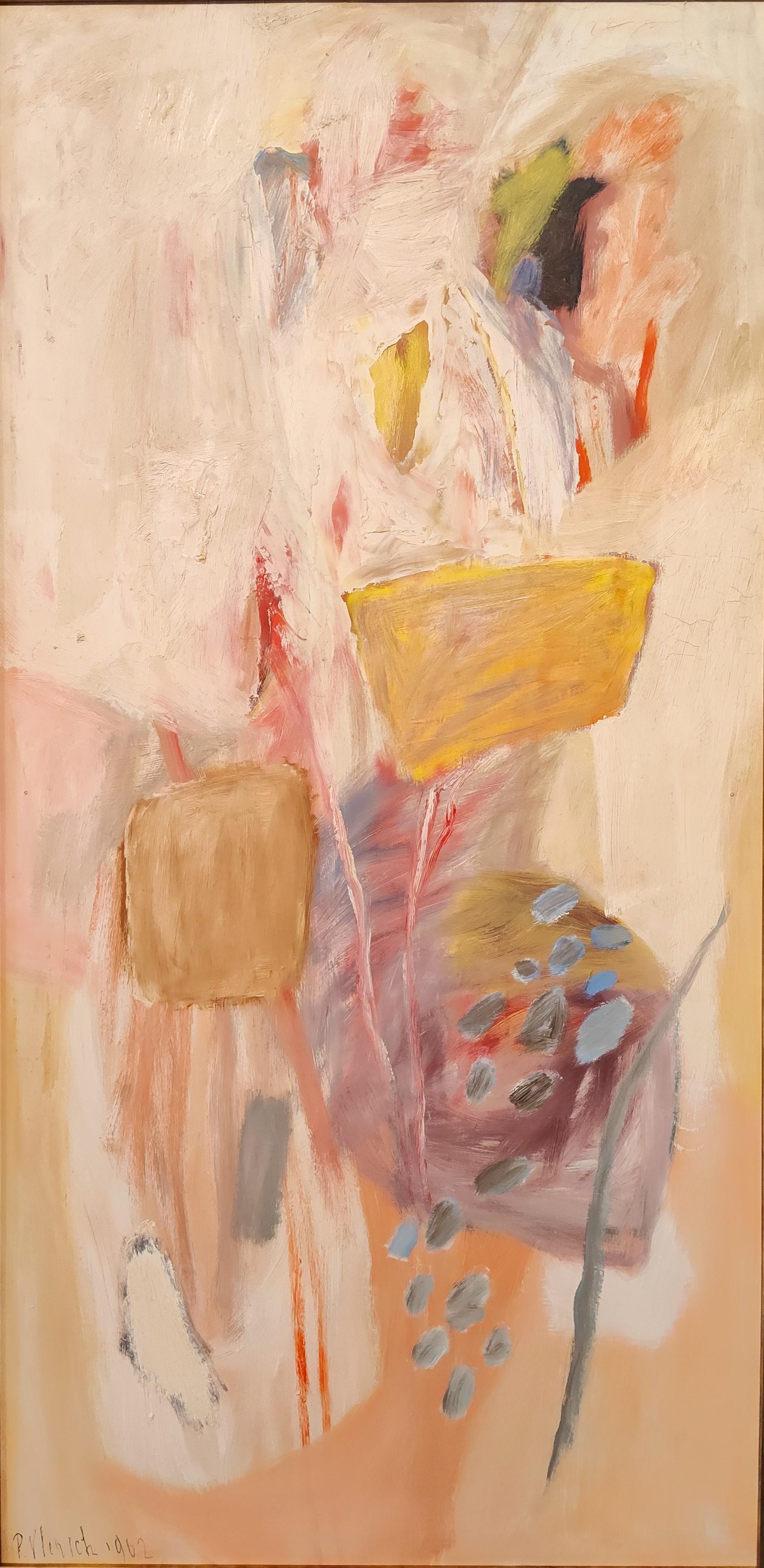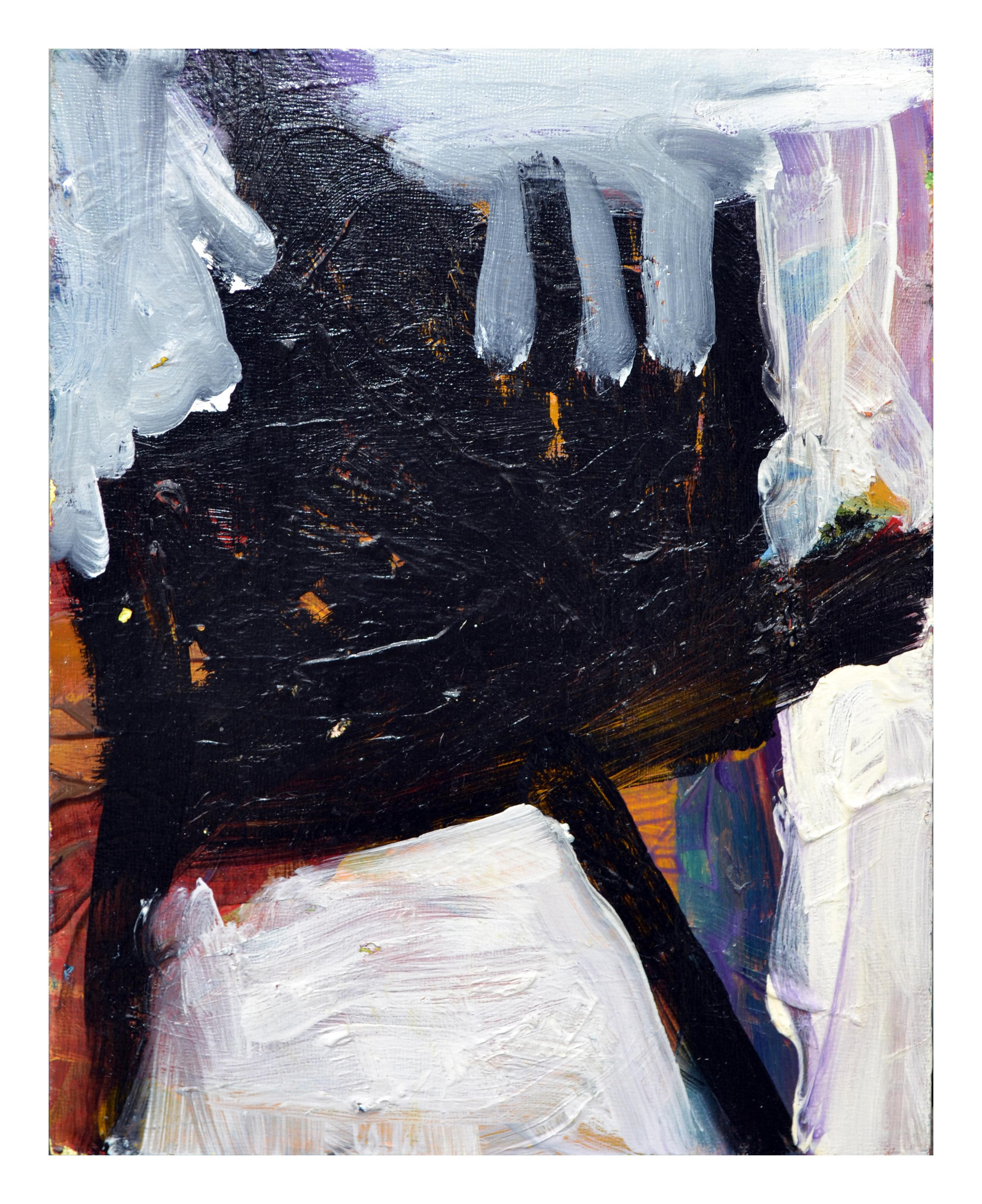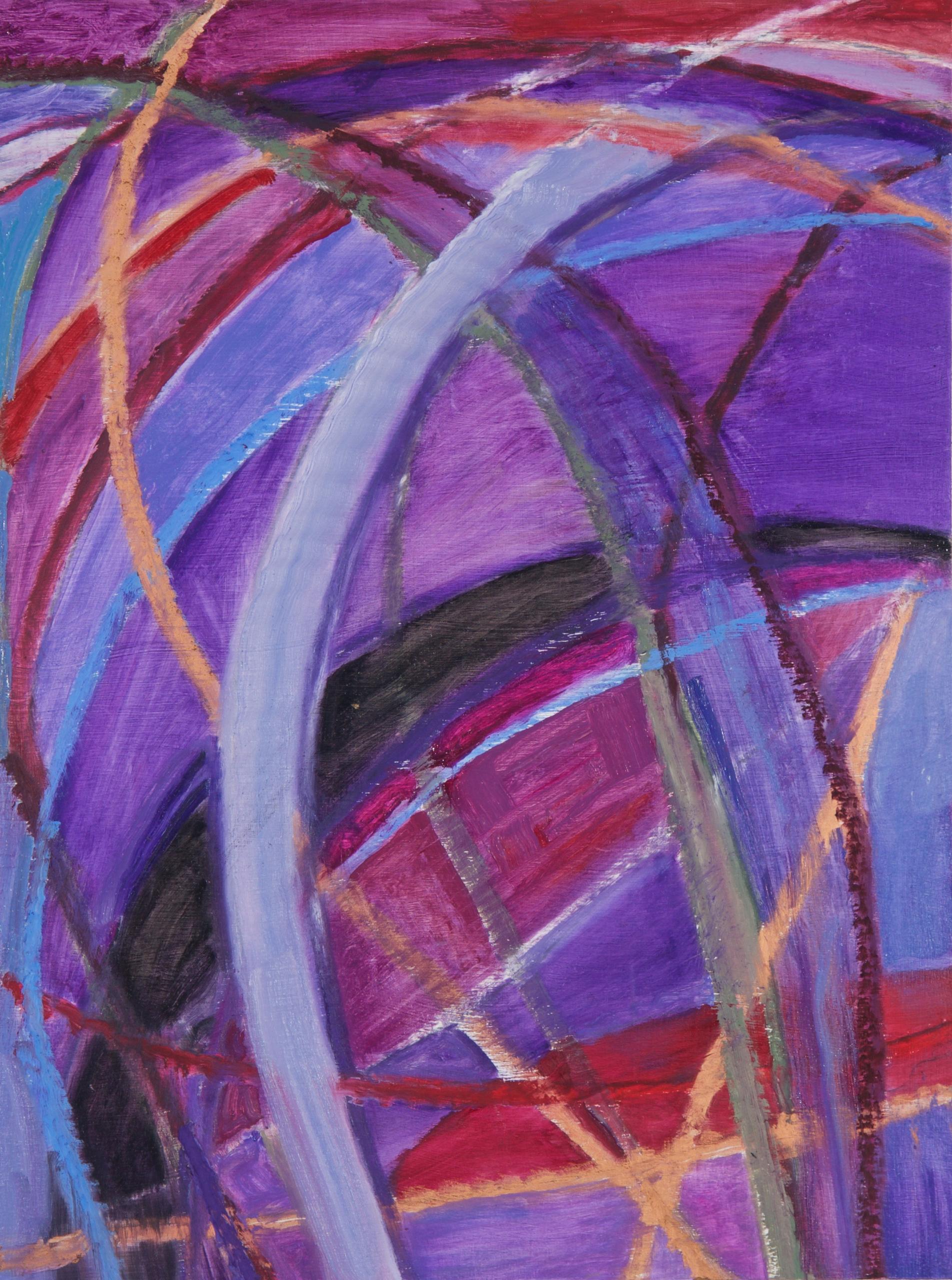Items Similar to Impressionism painting 21 Oil On Panels by Pierre Vlerick (1923 - 1999)
Want more images or videos?
Request additional images or videos from the seller
1 of 10
Pierre VlerickImpressionism painting 21 Oil On Panels by Pierre Vlerick (1923 - 1999)
About the Item
This painting is a perfect example of lyrical abstraction and a choice painting out of the best period of Vlerick's career.
Pierre Vlerick’s work shows some resemblance to Willem de Kooning’s. While the Dutch American was famous for the wild manner in which he treated his canvas, Pierre Vlerick showed some more restraint, but making a painting was in any case a slow process of stopping and starting and revising. His exploration is meant to result in a correct proportion of colour fields and streaks, often applied layer upon layer. All his colors have a luminous intensity. It was mainly Bonnard’s colorful work that inspired Vlerick to compose his own singular range of colors of slightly tingling yellows, greens, oranges and bits of blue here and there. Abstraction is emphasized by his use of color. Colors not associated with objects from daily life often dominate the composition: purple, for instance. This is the basis for his continuing abstraction, ending up as color fields combined with organic elements depicted with the vaguest of contours.
Though both artists create a very metropolitan, say even worldly art, their work evokes nature. De Kooning has been called a master of ‘abstract landscape’. The structure of Vlerick’s works, too, is very vegetable and organic. No wonder he referred to his paintings as his ‘gardens’. Neither artist allowed his garden to remain empty: de Kooning created a female figure, looking like a cross between a floozy and the mother goddess. Vlerick imagined a woman who is enjoying her body. Vlerick’s approach to abstract art is the same as de Kooning’s; they refuse to paint in a figurative manner, yet at the same time do not wish to renounce referring to reality.
De Kooning once put it very accurately during an interview when he conceded that painting the human figure any longer was absurd(in the post-war period), but also stated that it would be even more absurd not to do it. The only way out of this ambiguous dilemma is the deconstruction of the human figure. Not in order to reject it, but to show it in all its fragility.
Pierre Vlerick’s exceptional artistic talents were already recognized while he was studying at the Ghent Academy (1940-1944) whereupon graduating he received a gold medal.
In 1947-1948 Vlerick enrolls at the “la Grande Chaumière Academy”, a Parisian private academy which attracts lots of foreign artists thanks to the reputation of its most important teachers such as Maurice Denis (1870-1943). Denis was one of the founding fathers of “the Nabis” and is also considered to be the godfather of abstract art by many artists and art critics. Maurice Denis is famous for his quote: "Remember that a painting, before it is any kind of representation, is essentially a flat surface covered with colors in a certain collected order."
At La Grande Chaumière, Vlerick is challenged to develop a pictorial language of his own. Vlerick develops a way to translate the observed reality into visions of color and form, which can be situated somewhere on the axis between the figurative and the abstract. Reality is decomposed and reconstructed into a complete new representation.
After a trip to Spain in 1955 the painter evolves towards the use of brighter colors. At the Brussels World Exhibition of 1958 (Expo 58) Vlerick is for the first time confronted with real works of 17 American artists (William Baziotes, James Brooks, Sam Francis, Arshile Gorky, Adolph Gottlieb, Philip Guston, Grace Hartigan, Franz Kline, Willem de Kooning, Robert Motherwell, Barnett Newman, Jackson Pollock, Mark Rothko, Theodoros Stamos, Clyfford Still, Bradley Walker Tomlin and Jack Tworkov) and he is deeply impressed. This event pushes him even further into the direction of abstraction, and from 1959 onwards Pierre Vlerick radically evolves towards a lyrical abstraction. His abstract paintings from the first half of the 1960s are experimental and raw in their treatment of space and surface, and bewitching with their use of dazzling colors.
In the early 1960s the artist starts exhibiting abstract impressionist works at international shows such as the Carnegie Institute, (Pittsburgh 1961/1962); The Corcoran Gallery, (Washington D.C.1963) ; Venice Biennale (Belgian Pavilion), (Venice 1964); Musea de Arte Moderna, (Rio de Janeiro,1965).
Vlerick obtains a Fulbright scholarship, which enables him to stay in the States in 1964 and 1968. He also briefly teaches at the Harvard University in Boston. At the same time, Vlerick collaborated in curating the Forum exhibitions in Ghent in 1961-62-63, where the European avant-garde was prominently shown. This allowed him to be in close contact with the artists and their ideas.
To his credit, his work always remained very personal and original. Vlerick’s work is far removed from the explicitness of expressionism, from the sharp delineations of surrealism, from the angular multi-perspectives of cubism or the cool rationality of conceptualism. He is closer to the myopic outlook on the world typical of an impressionist’s observation and depiction of the world. The way he allows bright colors to fertilize one another is not far removed from Fauvism. And with Lyrical Abstraction, he shares the nerve to let compositions run out of control. One thing is resoundingly clear; he belongs to a post-1945 generation that did not feel like surrendering to the constraints of any one style.
- Creator:Pierre Vlerick (1923 - 1999)
- Dimensions:Height: 38.59 in (98 cm)Width: 53.55 in (136 cm)Depth: 2.76 in (7 cm)
- Medium:
- Movement & Style:
- Period:
- Condition:
- Gallery Location:Gent, BE
- Reference Number:1stDibs: LU2140212299672
About the Seller
5.0
Vetted Seller
These experienced sellers undergo a comprehensive evaluation by our team of in-house experts.
Established in 2018
1stDibs seller since 2022
Typical response time: 16 hours
- ShippingRetrieving quote...Ships From: Gent, Belgium
- Return PolicyA return for this item may be initiated within 10 days of delivery.
More From This SellerView All
- Impressionism painting No nightshade Oil on panel by Pierre VlerickLocated in Gent, VOVThis painting is a perfect example of lyrical abstraction and a choice painting out of the best period of Vlerick's career. Geen nachtschade (No Nightshade), 1962 Oil on Masonite board 121 x 61 cm (without frame) 136 x 75 cm (framed) Signed and dated bottom left ‘P. Vlerick 1962’& with title, signature place and date at the back Pierre Vlerick...Category
1960s Abstract Impressionist Abstract Paintings
MaterialsMasonite, Oil
- Impressionism painting 4 Oil on panel by Pierre Vlerick (1923 - 1999)Located in Gent, VOVThis painting is a perfect example of lyrical abstraction and a choice painting out of the best period of Vlerick's career. Pierre Vlerick’s work shows...Category
1960s Abstract Impressionist Abstract Paintings
MaterialsMasonite, Oil
- Abstract Impressionistic painting on board Ineffable by Pierre VlerickLocated in Gent, VOVThis painting is a perfect example of lyrical abstraction and a choice painting out of the best period of Vlerick's career. Ineffable, 1962 Oil on Masonite board 91,5 x 61,5 cm (without frame) 93 x 63 cm (framed) Signed and dated Top Right ‘P. Vlerick 1962’ with title, signature place and date at the back: Ineffable P. Vlerick Afsnee 1962 Pierre Vlerick’s work shows some resemblance to Willem de Kooning’s. While the Dutch American was famed for the wild manner in which he treated his canvas, Pierre Vlerick showed some more restraint, but making a painting was in any case a slow process of stopping and starting and revising. His exploration is meant to result in a correct proportion of colour fields and streaks, often applied layer upon layer. All his colors have a luminous intensity. It was mainly Bonnard’s colorful work that inspired Vlerick to compose his own singular range of colors of slightly tingling yellows, greens, oranges and bits of blue here and there. Abstraction is emphasized by his use of color. Colors not associated with objects from daily life often dominate the composition: purple, for instance. This is the basis for his continuing abstraction, ending up as color fields combined with organic elements depicted with the vaguest of contours. Though both artists create a very metropolitan, say even worldly art, their work evokes nature. De Kooning has been called a master of ‘abstract landscape’. The structure of Vlerick’s works, too, is very vegetable and organic. No wonder he referred to his paintings as his ‘gardens’. Neither artist allowed his garden to remain empty: de Kooning created a female figure looking like a cross between a floozy and the mother goddess. Vlerick imagined a woman who is enjoying her body. Vlerick’s approach to abstract art is the same as de Kooning’s; they refuse to paint in a figurative manner, yet at the same time do not wish to renounce referring to reality. De Kooning once put it very accurately during an interview when he conceded that painting the human figure any longer was absurd(in the post-war period), but also stated that it would be even more absurd not to do it. The only way out of this ambiguous dilemma is the deconstruction of the human figure. Not in order to reject it, but to show it in all its fragility. Pierre Vlerick’s exceptional artistic talents were already recognized while he was studying at the Ghent Academy (1940-1944) whereupon graduating he received a gold medal. In 1947-1948 Vlerick enrolls at the “la Grande Chaumière Academy”, a Parisian private academy which attracts lots of foreign artists thanks to the reputation of its most important teachers such as Maurice Denis (1870-1943). Denis was one of the founding fathers of “the Nabis” and is also considered to be the godfather of abstract art by many artists and art critics. Maurice Denis is famous for his quote: "Remember that a painting, before it is any kind of representation, is essentially a flat surface covered with colors in a certain collected order." At La Grande Chaumière, Vlerick is challenged to develop a pictorial language of his own. Vlerick develops a way to translate the observed reality into visions of color and form, which can be situated somewhere on the axis between the figurative and the abstract. Reality is decomposed and reconstructed into a complete new representation. After a trip to Spain in 1955 the painter evolves towards the use of brighter colors. At the Brussels World Exhibition of 1958 (Expo 58) Vlerick is for the first time confronted with real works of 17 American artists (William Baziotes, James Brooks, Sam Francis, Arshile Gorky, Adolph Gottlieb, Philip Guston, Grace Hartigan, Franz Kline, Willem de Kooning, Robert Motherwell, Barnett Newman, Jackson Pollock, Mark Rothko, Theodoros Stamos, Clyfford Still, Bradley Walker...Category
20th Century Abstract Paintings
MaterialsMasonite, Oil
- The Chapel Of Protection In CagnesBy Paul LeducLocated in Gent, VOVLa Chapelle de la Protection in Cagnes, circa 1925 Oil on panel, signed with the monogram lower left 27 x 34.5 cm Bibliography: The Painters of Cagnes, exhibition catalogue, Château-Musée Grimaldi, 2011, p.62 Paul Leduc...Category
1920s Impressionist Landscape Paintings
MaterialsOil, Panel
- Lady in a red dress with a kittenLocated in Gent, VOVSignature lower right: J. Bail Relined and some restorations Joseph-Claude Bail was born during a period of intense disagreement in the Parisian art world. For several years the Salon juries had rejected many progressive artists works; printmaking was making a charge at establishing itself as a true art form; the Barbizon group of painters challenged the tradition of historical landscapes with their views of the modern countryside, and Realism was decades old and had brought forth such combative figures as Gustave Courbet. Yet not all artists can be said to belong to this modern view of the nineteenth century. Numerous artists found prestige and public acclaim both at the Salons and with the public with works that relied on past styles and traditions influenced by the “Little Masters” from seventeenth-century Holland and traditions from eighteenth-century France. Joseph Bail...Category
Late 19th Century French School Figurative Paintings
MaterialsOil
- On the banks of the Meuse near Waulsort by François Roffiaen (1820-1898)Located in Gent, VOVOn the banks of the Meuse, near Waulsort (before the canalization of the Meuse) Signed lower right François Roffiaen (1820-1898): A Life in Brushstrokes His kin, born from humble s...Category
19th Century Landscape Paintings
MaterialsOil
You May Also Like
- Black & White Tension Abstract ImpressionismBy Kristin CohenLocated in Soquel, CAAbstract Impressionism primarily black and white painting by Kristin Cohen (American, b.1963). Purchased as part of her collection. Unsigned and...Category
1990s Abstract Impressionist Abstract Paintings
MaterialsMasonite, Oil
- Vintage Abstract Impressionist -- Figure in Blue PoolBy Kristin CohenLocated in Soquel, CACompelling figure in blue pool abstract impressionist painting by Kristin Cohen (American, b. 1963). Thick impasto oil and Alkyd acrylic paints in this colorful abstract. From a coll...Category
1980s Abstract Impressionist Abstract Paintings
MaterialsMasonite, Oil
- Cyan & Orange Seascape at Sunset by Victor PapkovLocated in Soquel, CAExpressive and colorful seascape by Vasil (Victor) Papkov (20th Century). The vivid cyan blue churning waves mirror the sky above, with a glowing orange sunset splitting the canvas o...Category
1980s Abstract Impressionist Landscape Paintings
MaterialsMasonite, Oil
- Homage to Color PurpleBy Susan MossLocated in Santa Monica, CAOil on birch panel.Category
2010s Abstract Impressionist Abstract Paintings
MaterialsBirch, Oil
- Light From AboveBy Downy Doxey MarshallLocated in Salt Lake City, UT"Light From Above" by Downy Doxey Marshall, oil on canvas, 36 X 36 inches (framed size: 38 x 38 inches), $5,500. "As a child I dreamt of having a pond in my backyard. The thoughts of floating in a glass bottom boat...Category
2010s Abstract Impressionist Landscape Paintings
MaterialsCanvas, Oil
- Meadow GossamerBy Downy Doxey MarshallLocated in Salt Lake City, UT"Meadow Gossamer" by Downy Doxey Marshall, oil on canvas, 24 x 24 inches (framed size: 26 x 26 inches), $3,500. "As a child I dreamt of having a pond in my backyard. The thoughts of floating in a glass bottom boat...Category
2010s Abstract Impressionist Landscape Paintings
MaterialsCanvas, Oil




